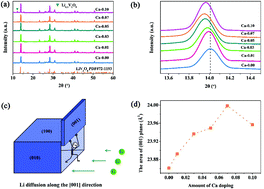Accelerating solid diffusion and suppressing phase transition in LiV3O8via calcium doping at lithium sites†
Abstract
The phase transition of LiV3O8 from an α phase to a β phase during the discharge/charge process leads to drastic structural change and rapid capacity decay, and the consequent sluggish Li+ solid-state diffusion results in a serious concentration polarization. Herein, Ca-doped LiV3O8 was rationally designed and synthesized to address these issues. The electrochemical behaviors of Ca-doped and undoped LiV3O8, together with their structural evolution and changes in the ion solid diffusion paths, are studied in detail. Calculations at the atomic scale have revealed that Ca doping effectively suppresses the undesired α–β phase transition and stabilizes the structure of LiV3O8 during cycling. Moreover, the calcium dopant preferentially situated at lithium sites in LiV3O8 serves as a pillar to increase the interlayer distance and extend the electrochemically active (001) plane, and thus facilitates anisotropic Li+ diffusion. More importantly, the variable-cell Nudged-Elastic-Band (VCNEB) calculations indicate that the phase transformation was hindered by kinetic factors, not by thermodynamics. The dominant factors for the electrochemical performance of LiV3O8 were clarified, and valuable insights for LiV3O8 commercialization in lithium-ion batteries were provided.



 Please wait while we load your content...
Please wait while we load your content...